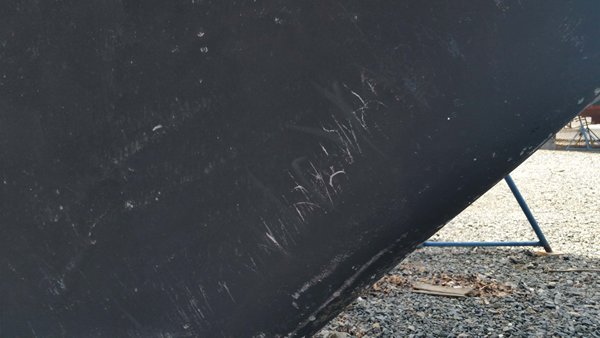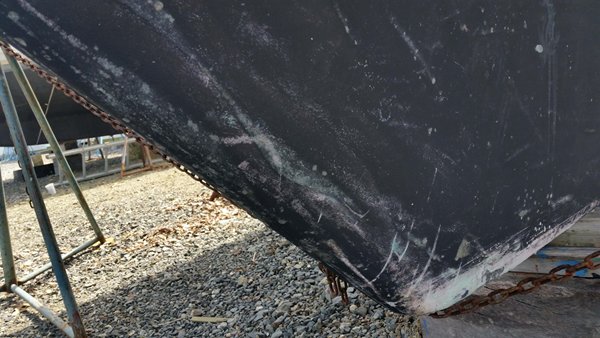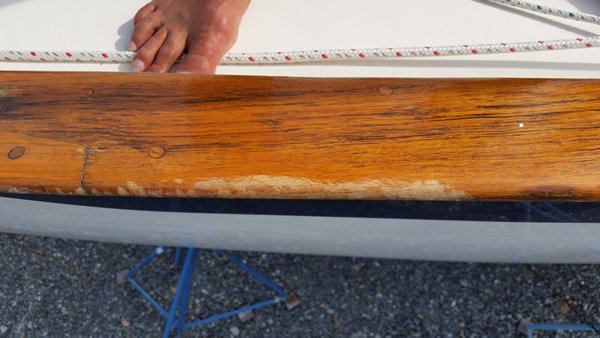Here is a summary and analysis of the "accident" we had while
sailing in the Chesapeake towards Oxford MD.
After having successfully sailed more than 1300 nm for 10 days in
the great open waters of the Atlantic we were sailing with a
North-East wind
on a close hauled course in the Chesapeake.
Because of the traffic and "proximity" to land, as soon as we
entered the Chesapeake, we switched from a 2 hours to 1 hour
watch schedule.
At midnight of May 19 we were on a starboard tack just west of
Ingram bay.
I instructed Jon to keep a close hauled course to try to stay
clear of the shallow area of Duck Blind and to call me for any
questions and
when it was time to tack.
I went to catch on some sleep and suddenly at 1 am I heard and
felt a collision.
I immediately got up from the settee were I was resting. As the
collision happen, Jon was about to come to wake me up and he was
also inside the cabin.
We both run out and we saw about 10 feet in front of the bow of
Blue Note a bunch of piling.
We let the jib flying and start the engine putting it in reverse.
For a moment I had a problem controlling the wheel and I was
afraid that the tiller was damaged, however soon I realized that
the autopilot was still engaged.
Once I disengaged the autopilot, the wheel felt normal and with
the motor we bear off to port, jibed and headed back East towards
the middle of the Chesapeake.
Although the engine sounded normal, as soon as away from the
dangerous area we switched the engine off and start sailing again.
We checked that no water was coming in the bilge, inspected the
hull near the bow and the only sign visible was a very light
scratch
on the port side cap rail.
We continued sailing a bit shaken by the collision towards Oxford
where we arrived in the early afternoon. The next day Blue Note
was schedule for a haul out and the only mark visible were some
light scratches on the front part of the keel.
Below you can see photos of what the Fishing Stakes looks like
(photo found on Google). There is also a screen capture of the
raster chart provided by NOAA
with Blue Note course. The stakes are marked on this chart but
they were not marked on the Navionic chart loaded in the Raymarine
chart-plotter.
Here are several lessons to be learned from this accident:
1) I should have gave more precise instructions to Jon on not to
get too close to shore and where to call me for tacking.
2) I should have checked the raster charts along the expected
course and warn Jon of the presence of the stakes.
3) I should have explained to Jon that the charts on the
Chart-plotter and the one on the laptop are different and that it
is good practice,
once a while, to cross check between them.
4) The presence of the Stakes are correctly reported on the
Navionics charts available online (http://webapp.navionics.com/)
so it's very much possible
that the updated Navionic chart do have marked the presence of the
stakes. This is a remind that it's better spending money for
updating
the charts than paying the consequence for what could have been a
very costly accident.
5) Jon was concentrating too much in checking the depth, the
reading was 27 feet right before the collision. Sometime it is
easier to look too much
at the chart-plotter and not long enough around the boat and where
the boat is heading. It was dark but almost full moon with some
clouds
and it might have been possible to see the stakes in time to tack
away.
6) It always help to get lucky !!!
I think what happen is that Blue Note decided to enter the fishing
stakes area just in the middle of tow poles.
The net was strong enough to act as a slingshot. The net was
loaded with the forward momentum of Blue Note and shoot her back
away from the piling.
Things could have been so much worst:
- We could have hit a pole straight on causing significant
damage to the pulpit.
- A shroud could have been caught by one of the piling
possibly bringing down the mast.
- We could have struck an underwater piling and breached the
hull.
- We could have get wedged between two piling
- We could had the prop or keel tangled by the net
Conclusion:
It is so much safer to sail in the open blue water of the
Atlantic. The danger is always higher while getting close to
shore.

Image of what "Fishing stakes" looks like during the day (image
from www.trekearth.com)
----

Course as recorded by Costal Explorer during the collision with
the fishing stakes.
Fishing stakes are marked on the USA-NOAA raster chart.

Online Navionic Charts (http://webapp.navionics.com/)
do show the presence of the fishing "Stakes".
-----

Data log of NavMonPC of the moment of the collision.
Decrease of Speed Trough Water (STW) goes from 4.3 kts to zero at
12:58:30 am. Speed Over Ground (SOG) does not shows such an abrupt
decrease because of the longer integration time.
------

Scratch marks on starboard side of the front section of the keel.
Probably due to the collision with net of the fishing stakes.
----

Scratch marks on port side of the front section of the keel.
Probably due to the collision with net of the fishing stakes.
----

Light scratch of the wood cap rail port side, about 3 feet fore
of midships, probably caused by rubbing against one of the poles.
A similar but lighter mark is on the starboard side.







